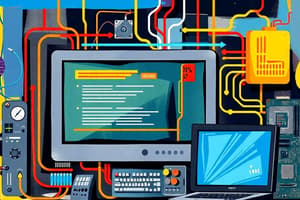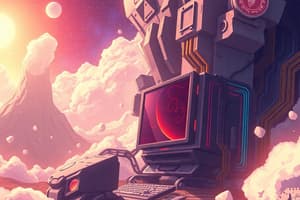Podcast
Questions and Answers
What does computational thinking primarily focus on?
What does computational thinking primarily focus on?
- Creating hardware components for computers
- Programming complex algorithms
- Developing user-friendly software interfaces
- Using computer science techniques to solve real-world problems (correct)
Which of the following best describes the difference between data and information?
Which of the following best describes the difference between data and information?
- Data is organized, while information is random.
- Data has no structure, but information is always numerical.
- Data is raw facts and figures, while information is processed and organized data. (correct)
- Data is processed facts, whereas information is raw facts.
Which of the following is classified as application software?
Which of the following is classified as application software?
- Utility Programs
- Word Processors (correct)
- Programming Languages
- Operating Systems
What is one of the key operations performed by a computer?
What is one of the key operations performed by a computer?
Which programming language is not explicitly mentioned as an example in the content?
Which programming language is not explicitly mentioned as an example in the content?
Which of the following best describes the role of data science?
Which of the following best describes the role of data science?
Which component is associated with the third generation of computers?
Which component is associated with the third generation of computers?
What is the primary function of a computer's basic logical structure?
What is the primary function of a computer's basic logical structure?
Which of the following pioneers is known for the concept of the Analytical Engine?
Which of the following pioneers is known for the concept of the Analytical Engine?
How does information differ from data in computing?
How does information differ from data in computing?
Flashcards are hidden until you start studying
Study Notes
Input and Output Units
- Input Unit: Devices for data entry into a computer.
- CPU (Central Processing Unit): The core of computer processing, which includes:
- Memory Unit: Stores data and instructions.
- Control Unit: Directs operations of the CPU.
- Arithmetic and Logic Unit (ALU): Performs calculations and logical operations.
- Output Unit: Devices that convey processed information to users.
Hardware vs. Software
- Hardware: Tangible components like the CPU, memory, and I/O devices.
- Software: Instructions or programs that tell hardware what to do, guiding task execution.
Types of Software
- System Software: Includes operating systems (like Windows, macOS) and utility programs.
- Application Software: Specialized programs, including word processors, spreadsheets, and games.
- Programming Languages: Tools for developing software, examples include C, Java, and Python.
Basic Computing Operations
- Computers perform four fundamental operations:
- Input: Receiving data.
- Process: Manipulating data.
- Output: Displaying results.
- Store: Saving data for future use.
Data, Information, and Programs
- Data: Raw, unorganized facts and figures (e.g., student names and marks).
- Information: Processed data, organized and meaningful (e.g., arranged names and calculated averages).
- Program: A sequence of instructions for a computer to complete specific tasks.
Computational Thinking
- Focuses on using computer science principles to address real-world issues.
- Involves structured problem-solving methods derived from computer science concepts.
Data Science and Cybersecurity
- Data Science: Uses statistics, machine learning, and data visualization to extract knowledge from data.
- Cybersecurity: Safeguards computer systems and networks against information breaches, theft, and harm.
History of Computing
- Evolution of Computers:
- Mechanical Devices: Early tools like the abacus and mechanical calculators.
- Electromechanical Devices: Innovations like the IBM Mark I.
- Electronic Computers: Key models included ENIAC and UNIVAC.
- Modern Digital Systems: Development of microprocessors and personal computing devices.
Key Milestones and Innovators
- Charles Babbage: Originator of the Analytical Engine concept.
- Alan Turing: Developed the Turing machine, foundational to theoretical computer science.
- John von Neumann: Established the architecture principles for computers.
- Bill Gates and Steve Jobs: Pioneers in personal computing.
Generations of Computers
- First Generation (1946-1954): Vacuum tubes.
- Second Generation (1955-1965): Transistors.
- Third Generation (1968-1975): Integrated Circuits (IC).
- Fourth Generation (1976-1980): Very Large Scale Integrated Circuits (VLSI).
- Fifth Generation (1980-present): Ultra Scale Integrated Circuits (ULSI) and microprocessors.
Basic Computer Operations
- Structure common across all computer types involves transforming input data into useful information.
- Algorithm Design: Creating step-by-step procedures to solve specific tasks.
- Implementation: Coding algorithms, utilizing programming languages and tools.
- Evaluation and Optimization: Refining solutions based on performance and feedback.
Systematic Problem-Solving Approach
- Understand the Problem: Grasp the nature of the issue at hand.
- Formulate a Model: Develop a representation of the problem.
- Develop an Algorithm: Create a sequence of steps to approach the problem.
- Implementation: Write the code based on the algorithm.
- Testing: Verify that the solution works correctly.
- Evaluation: Assess the effectiveness of the solution.
Practical Example: Average Grade Calculation
- Input: Collect all students' grades via keyboard or external storage.
- Process: Sum the grades and compute the average.
- Output: Present the result on a monitor, printer, or store it in external memory.
Understanding the Problem
- Clarify the inputs available, their meanings, formats, and any missing information before attempting to solve a problem.
Studying That Suits You
Use AI to generate personalized quizzes and flashcards to suit your learning preferences.



